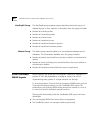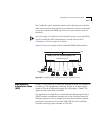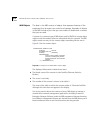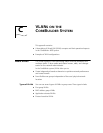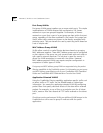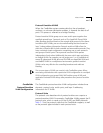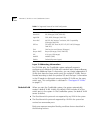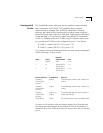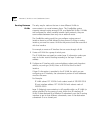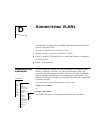
About VLANs C-5
Modifying the Default VLAN
New switch ports can dynamically appear in the CoreBuilder system if
you insert a new switching module (FESM, FSM).
When a new switch port that is not part of a default VLAN appears in the
system at initialization, the system software adds that switch port to the first
default VLAN defined in the system.
CoreBuilder VLANs also allow you to modify the initial default VLAN to form
two or more subsets of switch ports. If you remove the default VLAN and no
other VLANs are defined for the system, no flooding of traffic can occur.
How the
CoreBuilder System
Makes Flooding
Decisions
Protocol-sensitive VLANs directly affect how the CoreBuilder system
performs flooding. Without protocol-sensitive VLANs, the flooding
process is to forward data to all switch ports in the system. With
protocol-sensitive VLANs, the flooding process follows this model:
■ As a frame is received that needs to be flooded, it is decoded to determine
its protocol type.
■ If a VLAN exists for that protocol in the CoreBuilder system and the frame’s
source port is a member of the VLAN, the frame is flooded according to the
group of ports assigned to that VLAN.
■ If a VLAN exists for that protocol in the CoreBuilder system but the frame’s
source port is not a member of the VLAN definition, then the frame is
flooded according to the default VLAN assigned to that port.
■ If the protocol type of the received frame has no VLAN defined for it in the
system, the frame is flooded to the default VLAN for the receive port.




